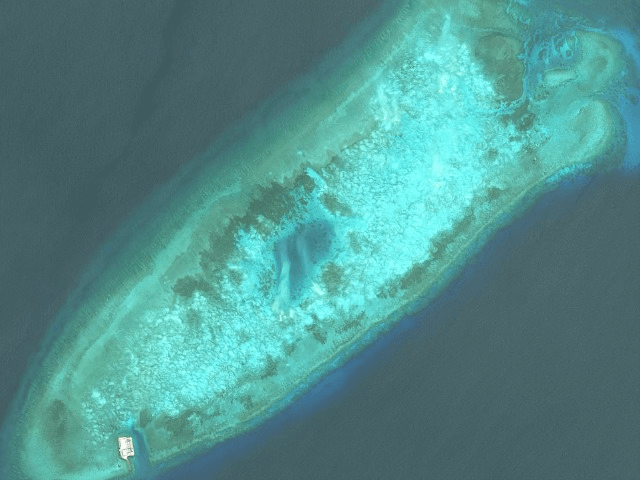The governments of Vietnam and the Philippines diverged significantly in their reactions to news that China has begun operating weather stations on their territory in the South China Sea. Vietnam released an outraged statement condemning China on Thursday, while Manila refused to condemn without “proof.”
The Chinese Communist Party boasted of the new illegal facilities in their state media this week, a move the Philippine government did not deem enough of an official confirmation of the activity.
China claims most of the South China Sea, including territory belonging to both of the countries mentioned as well as Brunei, Taiwan, Malaysia, and waters off the coast of Indonesia. It has developed advanced military facilities on artificial islands in the Spratly and Paracel Islands, which both Vietnam and the Philippines claim. China has also moved to ban Vietnamese fishermen from using Vietnamese sovereign waters for their trade and threatened Philippine ships in the area.
When confronted about its illegal behavior in the region, the Chinese government typically claims to have “ancient” ties to the entire South China Sea, claims deemed illegal in a 2016 Permanent Court of Arbitration ruling.
“The island construction by China is mainly for civilian purposes. It is reasonable and legitimate,” Defense Ministry spokesman Senior Col. Wu Qian argued in August. “It is a fact that the islands in the South China Sea have been the Chinese territory ever since the ancient times.”
While much of the development – which China denies – is military, Chinese state media outlets reported this week that new weather stations in the region were officially functioning.
The first reports on the facilities surfaced in the state-run Global Times newspaper a week ago.
“Meteorological stations on Yongshu Reef, Zhubi Reef and Meiji Reef of the Nansha [Spratly] Islands in the South China Sea began operating on Wednesday to provide fishermen and nearby ships with accurate weather forecasts,” the Times reported. The facilities will reportedly offer “round-the-clock weather forecasts” to compliment the airports, lighthouses, and surveillance infrastructure constructed on the territory.
Monitoring weather and pollution could make it easier for the Chinese government to dictate the use of surrounding international waters by accusing foreign ships of polluting the area or expelling them from a given part of the sea for alleged safety reasons. It is illegal under international law for China or any other nation to hinder free transit in international waters.
A day after the publication of the Global Times article, the Chinese Foreign Ministry confirmed the reports.
“The facilities will enable China to better provide public services to nations across the South China Sea,” spokesman Lu Kang told reporters.
China’s Pengpai News confirmed the news in yet another report, as did the regime’s broadcaster CCTV.
The government of Vietnam, which claims some of the reefs that China has illegally turned into artificial islands, responded to the reports on Thursday.
“The fact that China started use of meteorological observation stations on the illegally built structures in the Spratlys has seriously violated Vietnam’s sovereignty over the islands,” Vietnamese Foreign Ministry spokeswoman Le Thi Thu Hang told reporters. “Vietnam persistently opposes this act and asks China to immediately stop the above-said actions.”
Hang went on to accuse the Chinese government of “complicating the situation, affecting peace, security, and stability.” She did not suggest that Vietnam was planning any immediate action against China to respond to the launch of the weather stations.
The Philippines, in contrast, insisted that its officials still had to “confirm” the reports when questioned on Monday.
“The Department will take the appropriate action should these reports be validated,” Philippine Department of Foreign Affairs spokesperson Elmer Cato told reporters. A spokesman for the presidency, Salvador Panelo, insisted the government would not respond to the reports until they are confirmed, dismissing a statement from the Chinese Foreign Ministry as insufficient proof.
“It is in a wrong interest to validate any claim whether it’s for or against this government or for or against their own government,” Panelo argued. He has previously insisted on Monday that “these are news reports. We have not validated that. But if they are validated, I’m sure the new secretary of foreign affairs will do his job.”
Manila largely took the lead in challenging China on its claims before 2016, when current President Rodrigo Duterte assumed the head of government role. Beijing and Manila have since claimed “peace and stability” between the countries on the issue and Duterte has insisted that he cannot challenge China “because I’ll end up in a war, which we will be losing.”
Duterte’s China policy has proven unpopular; polls have found nearly three-quarters of Philippine citizens want Duterte to directly challenge China’s illegal colonization of their territory.
Vietnam, on the contrary, has increasingly demanded China vacate its land. In 2016, reports surfaced that the Vietnamese government had begun its won artificial island project in the South China Sea to compete with China. Vietnam has also forged closer relations with Japan and India, both of which also face illegal Chinese incursions into their sovereign territory, seeking support in the event of a military confrontation.

COMMENTS
Please let us know if you're having issues with commenting.